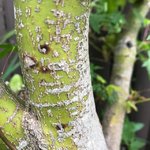I bought this acer last year at home depot for $30 and so far it has been doing great, but this week noticed a few issues. The bark near the soil line was separating from the tree, and when I went to inspect further it came right off. The bark on the roots underneath are also black and after repotting earlier, mostly dead in that section. This was not in the best soil so felt it was time to get into something better. When reducing the roots, I took off a decent section of taproot and noticed the black area. I have pretty minimal experience with maples but my first thought was Verticillium, however the tree has seemed healthy otherwise minus some black spots (pictured) which I have noticed since picking it up. Would be sad to loose this one, all feedback is appreciated.






Last edited:



